Exploring Social Media's Influence on Organizations and Strategies
VerifiedAdded on 2023/06/13
|12
|3213
|341
Essay
AI Summary
This essay examines the multifaceted impact of social media on organizations and their employees. It begins by defining social media and its evolution from a tool for personal communication to an indispensable asset for businesses, governments, and politicians. The essay highlights the role of social media in facilitating communication, marketing, and relationship building with customers. It further delves into the positive and negative impacts of social media on organizations, including enhanced information sharing, employee bonding, and improved marketing, while also addressing security concerns, potential for harassment, and productivity loss. Additionally, the essay explores the effects of social media on employees, noting benefits such as improved communication and knowledge sharing, alongside risks like data theft and reduced productivity. Finally, it discusses strategies for organizations to effectively manage social media, emphasizing the importance of cohesive planning, leadership, and employee education to align social media use with organizational goals.
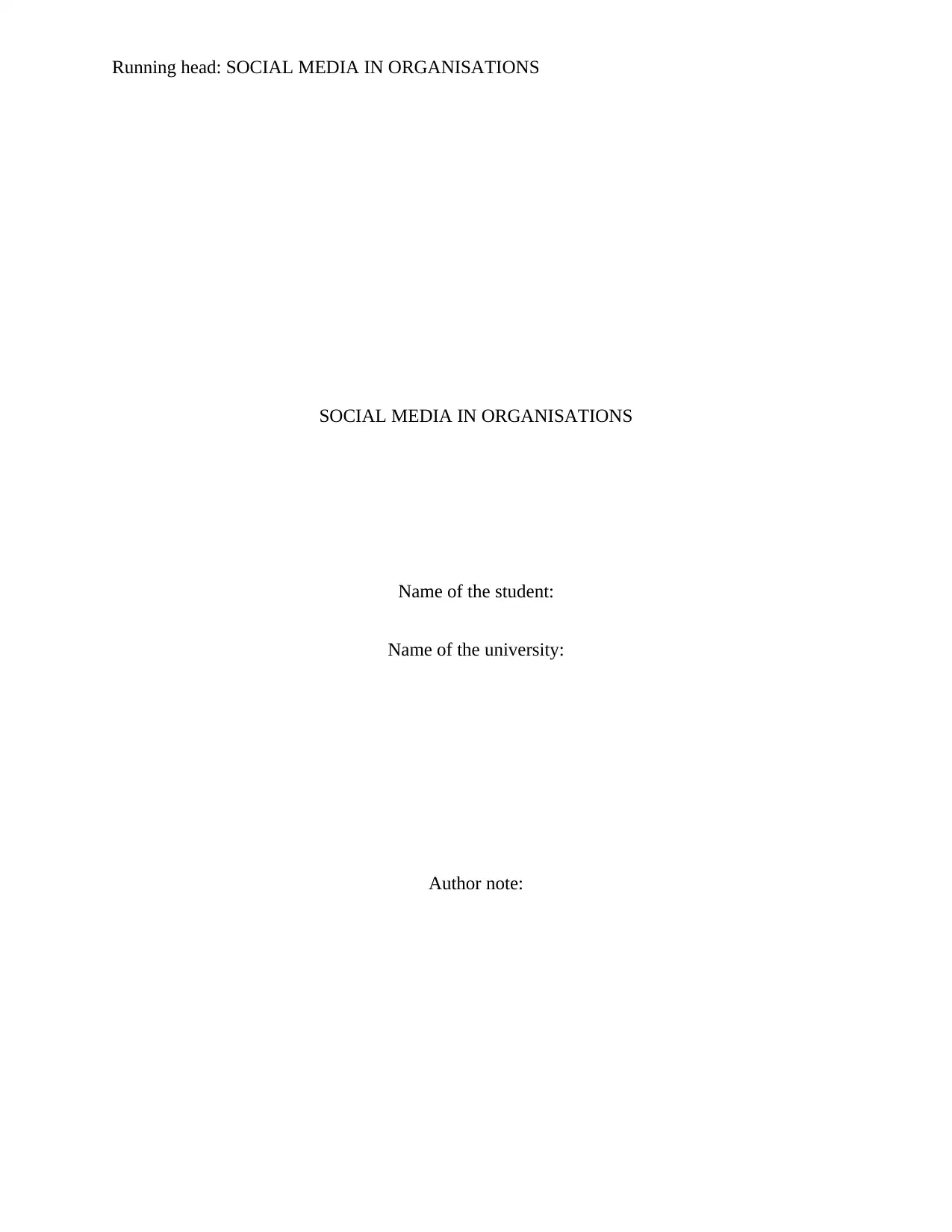
Running head: SOCIAL MEDIA IN ORGANISATIONS
SOCIAL MEDIA IN ORGANISATIONS
Name of the student:
Name of the university:
Author note:
SOCIAL MEDIA IN ORGANISATIONS
Name of the student:
Name of the university:
Author note:
Paraphrase This Document
Need a fresh take? Get an instant paraphrase of this document with our AI Paraphraser
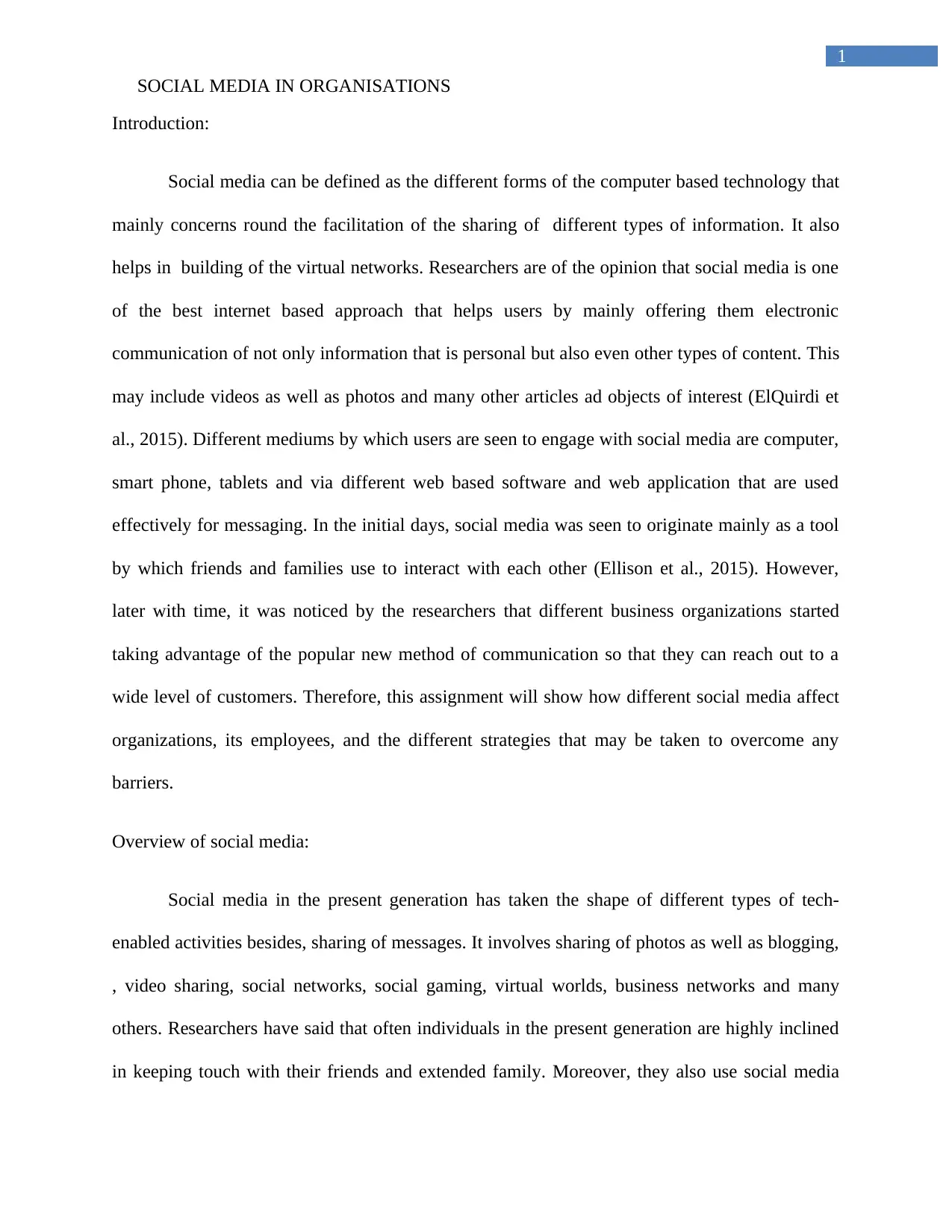
1
SOCIAL MEDIA IN ORGANISATIONS
Introduction:
Social media can be defined as the different forms of the computer based technology that
mainly concerns round the facilitation of the sharing of different types of information. It also
helps in building of the virtual networks. Researchers are of the opinion that social media is one
of the best internet based approach that helps users by mainly offering them electronic
communication of not only information that is personal but also even other types of content. This
may include videos as well as photos and many other articles ad objects of interest (ElQuirdi et
al., 2015). Different mediums by which users are seen to engage with social media are computer,
smart phone, tablets and via different web based software and web application that are used
effectively for messaging. In the initial days, social media was seen to originate mainly as a tool
by which friends and families use to interact with each other (Ellison et al., 2015). However,
later with time, it was noticed by the researchers that different business organizations started
taking advantage of the popular new method of communication so that they can reach out to a
wide level of customers. Therefore, this assignment will show how different social media affect
organizations, its employees, and the different strategies that may be taken to overcome any
barriers.
Overview of social media:
Social media in the present generation has taken the shape of different types of tech-
enabled activities besides, sharing of messages. It involves sharing of photos as well as blogging,
, video sharing, social networks, social gaming, virtual worlds, business networks and many
others. Researchers have said that often individuals in the present generation are highly inclined
in keeping touch with their friends and extended family. Moreover, they also use social media
SOCIAL MEDIA IN ORGANISATIONS
Introduction:
Social media can be defined as the different forms of the computer based technology that
mainly concerns round the facilitation of the sharing of different types of information. It also
helps in building of the virtual networks. Researchers are of the opinion that social media is one
of the best internet based approach that helps users by mainly offering them electronic
communication of not only information that is personal but also even other types of content. This
may include videos as well as photos and many other articles ad objects of interest (ElQuirdi et
al., 2015). Different mediums by which users are seen to engage with social media are computer,
smart phone, tablets and via different web based software and web application that are used
effectively for messaging. In the initial days, social media was seen to originate mainly as a tool
by which friends and families use to interact with each other (Ellison et al., 2015). However,
later with time, it was noticed by the researchers that different business organizations started
taking advantage of the popular new method of communication so that they can reach out to a
wide level of customers. Therefore, this assignment will show how different social media affect
organizations, its employees, and the different strategies that may be taken to overcome any
barriers.
Overview of social media:
Social media in the present generation has taken the shape of different types of tech-
enabled activities besides, sharing of messages. It involves sharing of photos as well as blogging,
, video sharing, social networks, social gaming, virtual worlds, business networks and many
others. Researchers have said that often individuals in the present generation are highly inclined
in keeping touch with their friends and extended family. Moreover, they also use social media
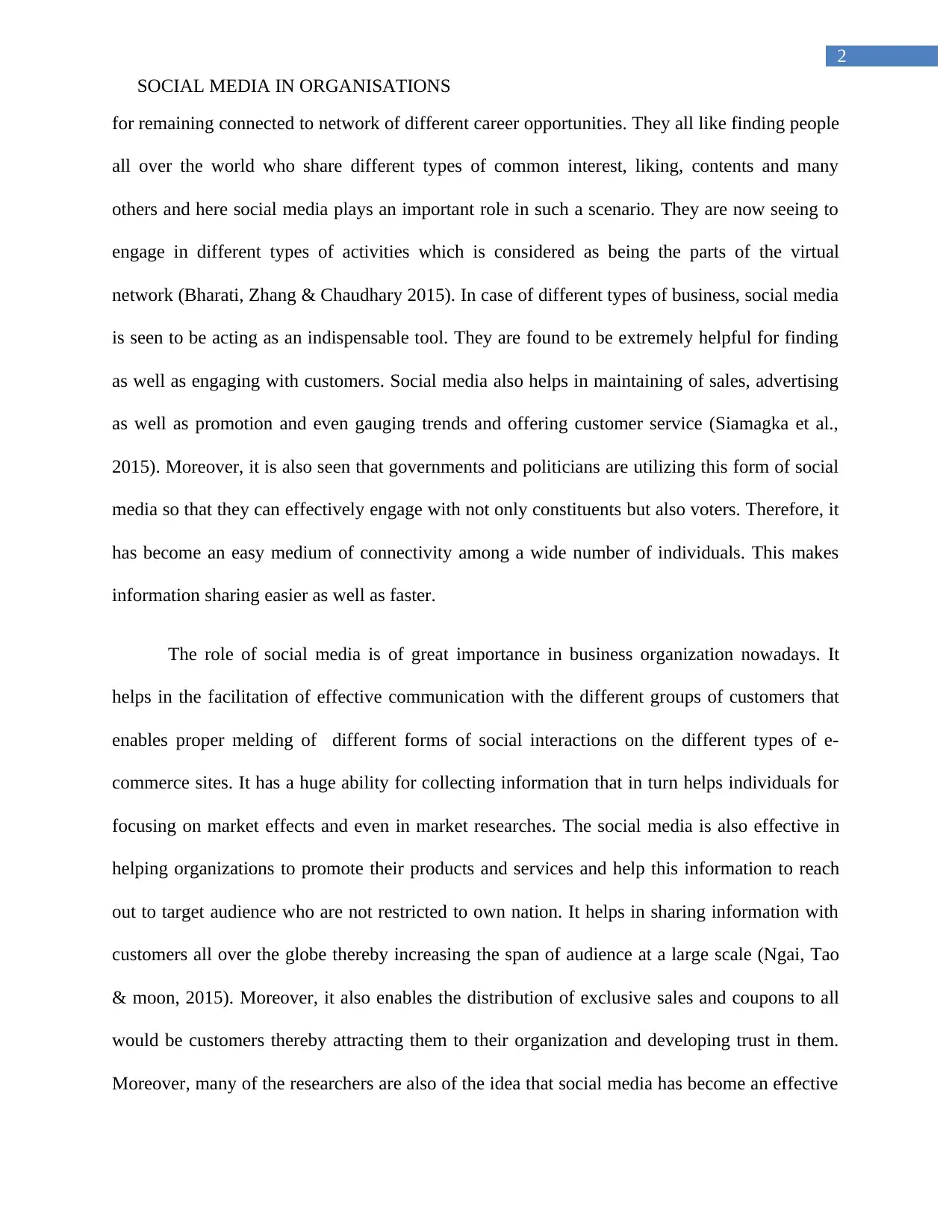
2
SOCIAL MEDIA IN ORGANISATIONS
for remaining connected to network of different career opportunities. They all like finding people
all over the world who share different types of common interest, liking, contents and many
others and here social media plays an important role in such a scenario. They are now seeing to
engage in different types of activities which is considered as being the parts of the virtual
network (Bharati, Zhang & Chaudhary 2015). In case of different types of business, social media
is seen to be acting as an indispensable tool. They are found to be extremely helpful for finding
as well as engaging with customers. Social media also helps in maintaining of sales, advertising
as well as promotion and even gauging trends and offering customer service (Siamagka et al.,
2015). Moreover, it is also seen that governments and politicians are utilizing this form of social
media so that they can effectively engage with not only constituents but also voters. Therefore, it
has become an easy medium of connectivity among a wide number of individuals. This makes
information sharing easier as well as faster.
The role of social media is of great importance in business organization nowadays. It
helps in the facilitation of effective communication with the different groups of customers that
enables proper melding of different forms of social interactions on the different types of e-
commerce sites. It has a huge ability for collecting information that in turn helps individuals for
focusing on market effects and even in market researches. The social media is also effective in
helping organizations to promote their products and services and help this information to reach
out to target audience who are not restricted to own nation. It helps in sharing information with
customers all over the globe thereby increasing the span of audience at a large scale (Ngai, Tao
& moon, 2015). Moreover, it also enables the distribution of exclusive sales and coupons to all
would be customers thereby attracting them to their organization and developing trust in them.
Moreover, many of the researchers are also of the idea that social media has become an effective
SOCIAL MEDIA IN ORGANISATIONS
for remaining connected to network of different career opportunities. They all like finding people
all over the world who share different types of common interest, liking, contents and many
others and here social media plays an important role in such a scenario. They are now seeing to
engage in different types of activities which is considered as being the parts of the virtual
network (Bharati, Zhang & Chaudhary 2015). In case of different types of business, social media
is seen to be acting as an indispensable tool. They are found to be extremely helpful for finding
as well as engaging with customers. Social media also helps in maintaining of sales, advertising
as well as promotion and even gauging trends and offering customer service (Siamagka et al.,
2015). Moreover, it is also seen that governments and politicians are utilizing this form of social
media so that they can effectively engage with not only constituents but also voters. Therefore, it
has become an easy medium of connectivity among a wide number of individuals. This makes
information sharing easier as well as faster.
The role of social media is of great importance in business organization nowadays. It
helps in the facilitation of effective communication with the different groups of customers that
enables proper melding of different forms of social interactions on the different types of e-
commerce sites. It has a huge ability for collecting information that in turn helps individuals for
focusing on market effects and even in market researches. The social media is also effective in
helping organizations to promote their products and services and help this information to reach
out to target audience who are not restricted to own nation. It helps in sharing information with
customers all over the globe thereby increasing the span of audience at a large scale (Ngai, Tao
& moon, 2015). Moreover, it also enables the distribution of exclusive sales and coupons to all
would be customers thereby attracting them to their organization and developing trust in them.
Moreover, many of the researchers are also of the idea that social media has become an effective
⊘ This is a preview!⊘
Do you want full access?
Subscribe today to unlock all pages.

Trusted by 1+ million students worldwide
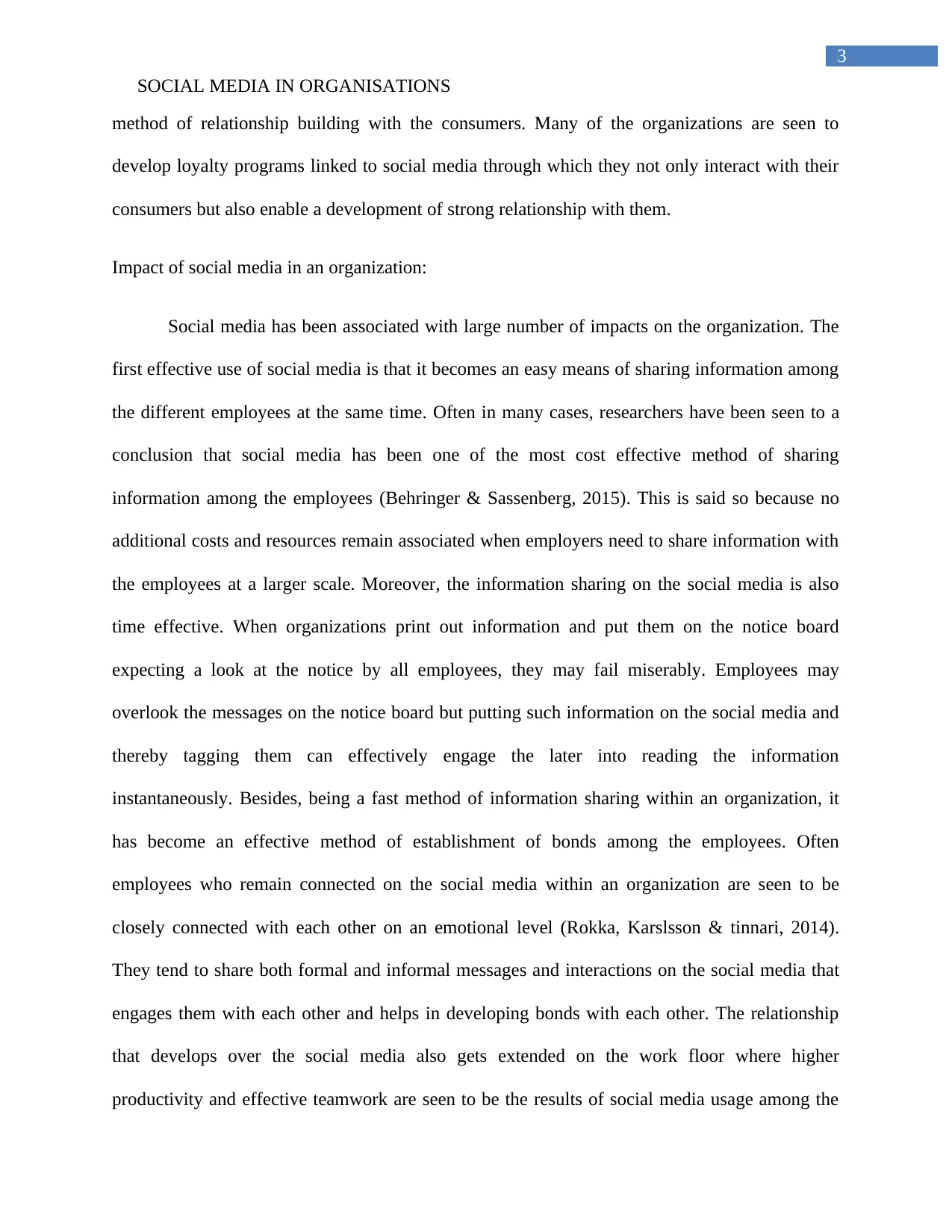
3
SOCIAL MEDIA IN ORGANISATIONS
method of relationship building with the consumers. Many of the organizations are seen to
develop loyalty programs linked to social media through which they not only interact with their
consumers but also enable a development of strong relationship with them.
Impact of social media in an organization:
Social media has been associated with large number of impacts on the organization. The
first effective use of social media is that it becomes an easy means of sharing information among
the different employees at the same time. Often in many cases, researchers have been seen to a
conclusion that social media has been one of the most cost effective method of sharing
information among the employees (Behringer & Sassenberg, 2015). This is said so because no
additional costs and resources remain associated when employers need to share information with
the employees at a larger scale. Moreover, the information sharing on the social media is also
time effective. When organizations print out information and put them on the notice board
expecting a look at the notice by all employees, they may fail miserably. Employees may
overlook the messages on the notice board but putting such information on the social media and
thereby tagging them can effectively engage the later into reading the information
instantaneously. Besides, being a fast method of information sharing within an organization, it
has become an effective method of establishment of bonds among the employees. Often
employees who remain connected on the social media within an organization are seen to be
closely connected with each other on an emotional level (Rokka, Karslsson & tinnari, 2014).
They tend to share both formal and informal messages and interactions on the social media that
engages them with each other and helps in developing bonds with each other. The relationship
that develops over the social media also gets extended on the work floor where higher
productivity and effective teamwork are seen to be the results of social media usage among the
SOCIAL MEDIA IN ORGANISATIONS
method of relationship building with the consumers. Many of the organizations are seen to
develop loyalty programs linked to social media through which they not only interact with their
consumers but also enable a development of strong relationship with them.
Impact of social media in an organization:
Social media has been associated with large number of impacts on the organization. The
first effective use of social media is that it becomes an easy means of sharing information among
the different employees at the same time. Often in many cases, researchers have been seen to a
conclusion that social media has been one of the most cost effective method of sharing
information among the employees (Behringer & Sassenberg, 2015). This is said so because no
additional costs and resources remain associated when employers need to share information with
the employees at a larger scale. Moreover, the information sharing on the social media is also
time effective. When organizations print out information and put them on the notice board
expecting a look at the notice by all employees, they may fail miserably. Employees may
overlook the messages on the notice board but putting such information on the social media and
thereby tagging them can effectively engage the later into reading the information
instantaneously. Besides, being a fast method of information sharing within an organization, it
has become an effective method of establishment of bonds among the employees. Often
employees who remain connected on the social media within an organization are seen to be
closely connected with each other on an emotional level (Rokka, Karslsson & tinnari, 2014).
They tend to share both formal and informal messages and interactions on the social media that
engages them with each other and helps in developing bonds with each other. The relationship
that develops over the social media also gets extended on the work floor where higher
productivity and effective teamwork are seen to be the results of social media usage among the
Paraphrase This Document
Need a fresh take? Get an instant paraphrase of this document with our AI Paraphraser
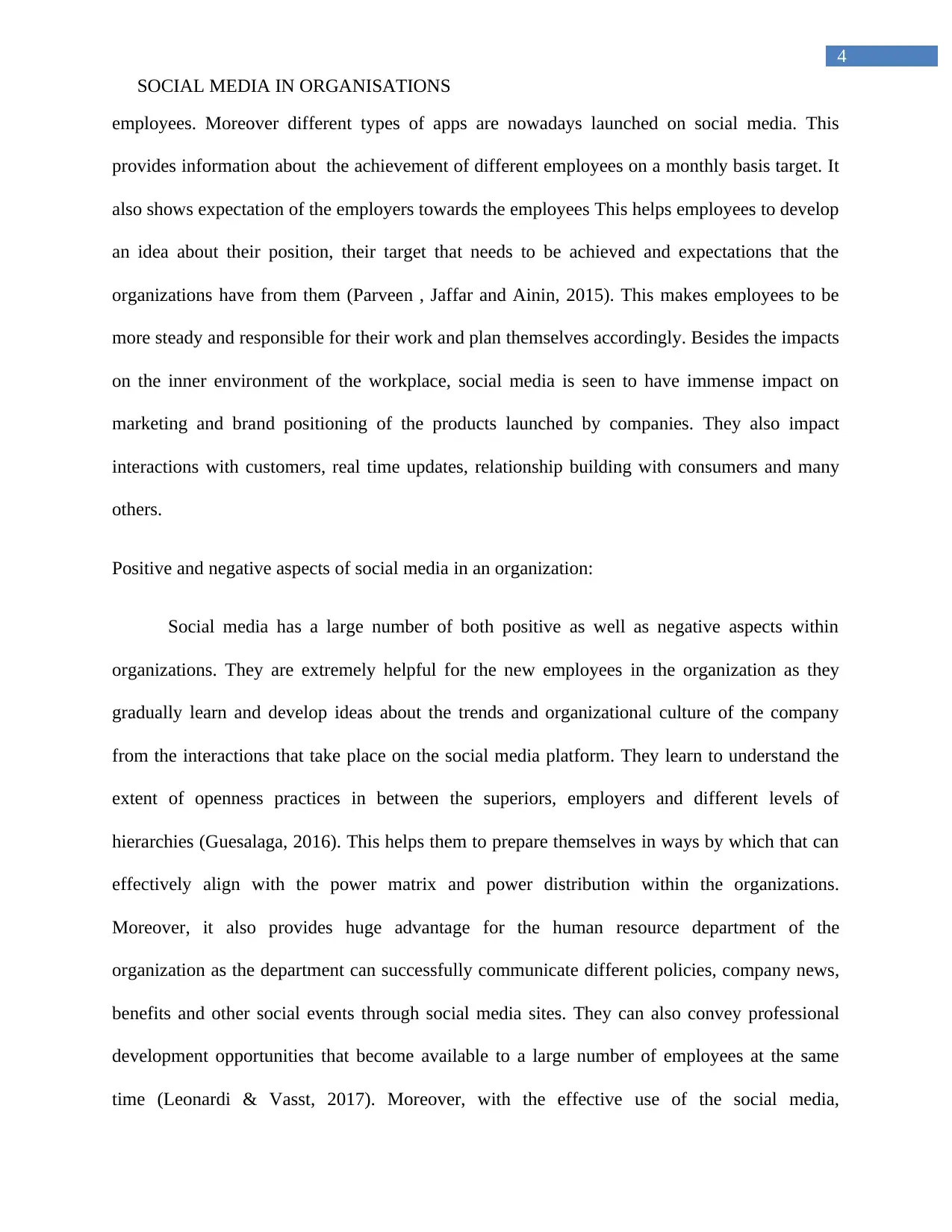
4
SOCIAL MEDIA IN ORGANISATIONS
employees. Moreover different types of apps are nowadays launched on social media. This
provides information about the achievement of different employees on a monthly basis target. It
also shows expectation of the employers towards the employees This helps employees to develop
an idea about their position, their target that needs to be achieved and expectations that the
organizations have from them (Parveen , Jaffar and Ainin, 2015). This makes employees to be
more steady and responsible for their work and plan themselves accordingly. Besides the impacts
on the inner environment of the workplace, social media is seen to have immense impact on
marketing and brand positioning of the products launched by companies. They also impact
interactions with customers, real time updates, relationship building with consumers and many
others.
Positive and negative aspects of social media in an organization:
Social media has a large number of both positive as well as negative aspects within
organizations. They are extremely helpful for the new employees in the organization as they
gradually learn and develop ideas about the trends and organizational culture of the company
from the interactions that take place on the social media platform. They learn to understand the
extent of openness practices in between the superiors, employers and different levels of
hierarchies (Guesalaga, 2016). This helps them to prepare themselves in ways by which that can
effectively align with the power matrix and power distribution within the organizations.
Moreover, it also provides huge advantage for the human resource department of the
organization as the department can successfully communicate different policies, company news,
benefits and other social events through social media sites. They can also convey professional
development opportunities that become available to a large number of employees at the same
time (Leonardi & Vasst, 2017). Moreover, with the effective use of the social media,
SOCIAL MEDIA IN ORGANISATIONS
employees. Moreover different types of apps are nowadays launched on social media. This
provides information about the achievement of different employees on a monthly basis target. It
also shows expectation of the employers towards the employees This helps employees to develop
an idea about their position, their target that needs to be achieved and expectations that the
organizations have from them (Parveen , Jaffar and Ainin, 2015). This makes employees to be
more steady and responsible for their work and plan themselves accordingly. Besides the impacts
on the inner environment of the workplace, social media is seen to have immense impact on
marketing and brand positioning of the products launched by companies. They also impact
interactions with customers, real time updates, relationship building with consumers and many
others.
Positive and negative aspects of social media in an organization:
Social media has a large number of both positive as well as negative aspects within
organizations. They are extremely helpful for the new employees in the organization as they
gradually learn and develop ideas about the trends and organizational culture of the company
from the interactions that take place on the social media platform. They learn to understand the
extent of openness practices in between the superiors, employers and different levels of
hierarchies (Guesalaga, 2016). This helps them to prepare themselves in ways by which that can
effectively align with the power matrix and power distribution within the organizations.
Moreover, it also provides huge advantage for the human resource department of the
organization as the department can successfully communicate different policies, company news,
benefits and other social events through social media sites. They can also convey professional
development opportunities that become available to a large number of employees at the same
time (Leonardi & Vasst, 2017). Moreover, with the effective use of the social media,
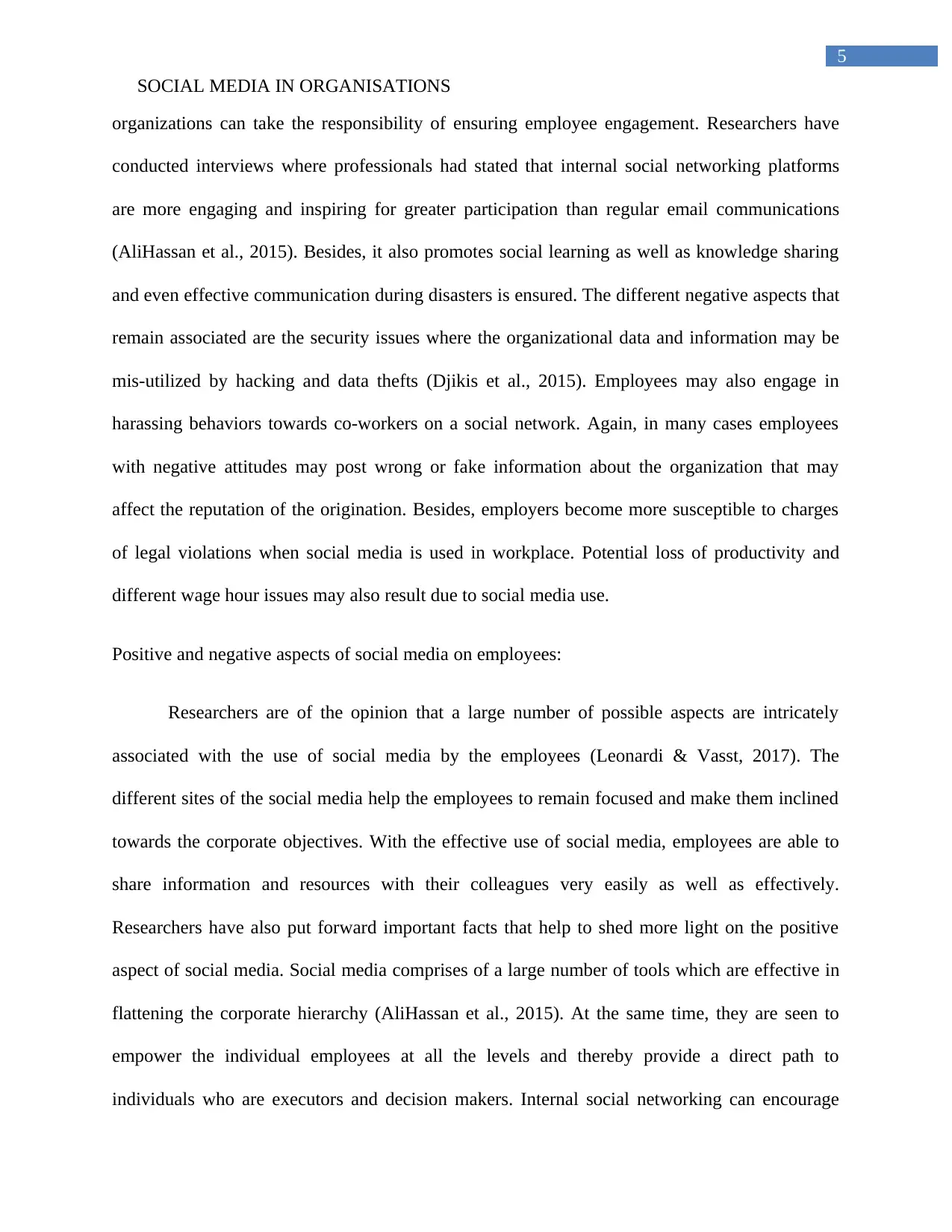
5
SOCIAL MEDIA IN ORGANISATIONS
organizations can take the responsibility of ensuring employee engagement. Researchers have
conducted interviews where professionals had stated that internal social networking platforms
are more engaging and inspiring for greater participation than regular email communications
(AliHassan et al., 2015). Besides, it also promotes social learning as well as knowledge sharing
and even effective communication during disasters is ensured. The different negative aspects that
remain associated are the security issues where the organizational data and information may be
mis-utilized by hacking and data thefts (Djikis et al., 2015). Employees may also engage in
harassing behaviors towards co-workers on a social network. Again, in many cases employees
with negative attitudes may post wrong or fake information about the organization that may
affect the reputation of the origination. Besides, employers become more susceptible to charges
of legal violations when social media is used in workplace. Potential loss of productivity and
different wage hour issues may also result due to social media use.
Positive and negative aspects of social media on employees:
Researchers are of the opinion that a large number of possible aspects are intricately
associated with the use of social media by the employees (Leonardi & Vasst, 2017). The
different sites of the social media help the employees to remain focused and make them inclined
towards the corporate objectives. With the effective use of social media, employees are able to
share information and resources with their colleagues very easily as well as effectively.
Researchers have also put forward important facts that help to shed more light on the positive
aspect of social media. Social media comprises of a large number of tools which are effective in
flattening the corporate hierarchy (AliHassan et al., 2015). At the same time, they are seen to
empower the individual employees at all the levels and thereby provide a direct path to
individuals who are executors and decision makers. Internal social networking can encourage
SOCIAL MEDIA IN ORGANISATIONS
organizations can take the responsibility of ensuring employee engagement. Researchers have
conducted interviews where professionals had stated that internal social networking platforms
are more engaging and inspiring for greater participation than regular email communications
(AliHassan et al., 2015). Besides, it also promotes social learning as well as knowledge sharing
and even effective communication during disasters is ensured. The different negative aspects that
remain associated are the security issues where the organizational data and information may be
mis-utilized by hacking and data thefts (Djikis et al., 2015). Employees may also engage in
harassing behaviors towards co-workers on a social network. Again, in many cases employees
with negative attitudes may post wrong or fake information about the organization that may
affect the reputation of the origination. Besides, employers become more susceptible to charges
of legal violations when social media is used in workplace. Potential loss of productivity and
different wage hour issues may also result due to social media use.
Positive and negative aspects of social media on employees:
Researchers are of the opinion that a large number of possible aspects are intricately
associated with the use of social media by the employees (Leonardi & Vasst, 2017). The
different sites of the social media help the employees to remain focused and make them inclined
towards the corporate objectives. With the effective use of social media, employees are able to
share information and resources with their colleagues very easily as well as effectively.
Researchers have also put forward important facts that help to shed more light on the positive
aspect of social media. Social media comprises of a large number of tools which are effective in
flattening the corporate hierarchy (AliHassan et al., 2015). At the same time, they are seen to
empower the individual employees at all the levels and thereby provide a direct path to
individuals who are executors and decision makers. Internal social networking can encourage
⊘ This is a preview!⊘
Do you want full access?
Subscribe today to unlock all pages.

Trusted by 1+ million students worldwide
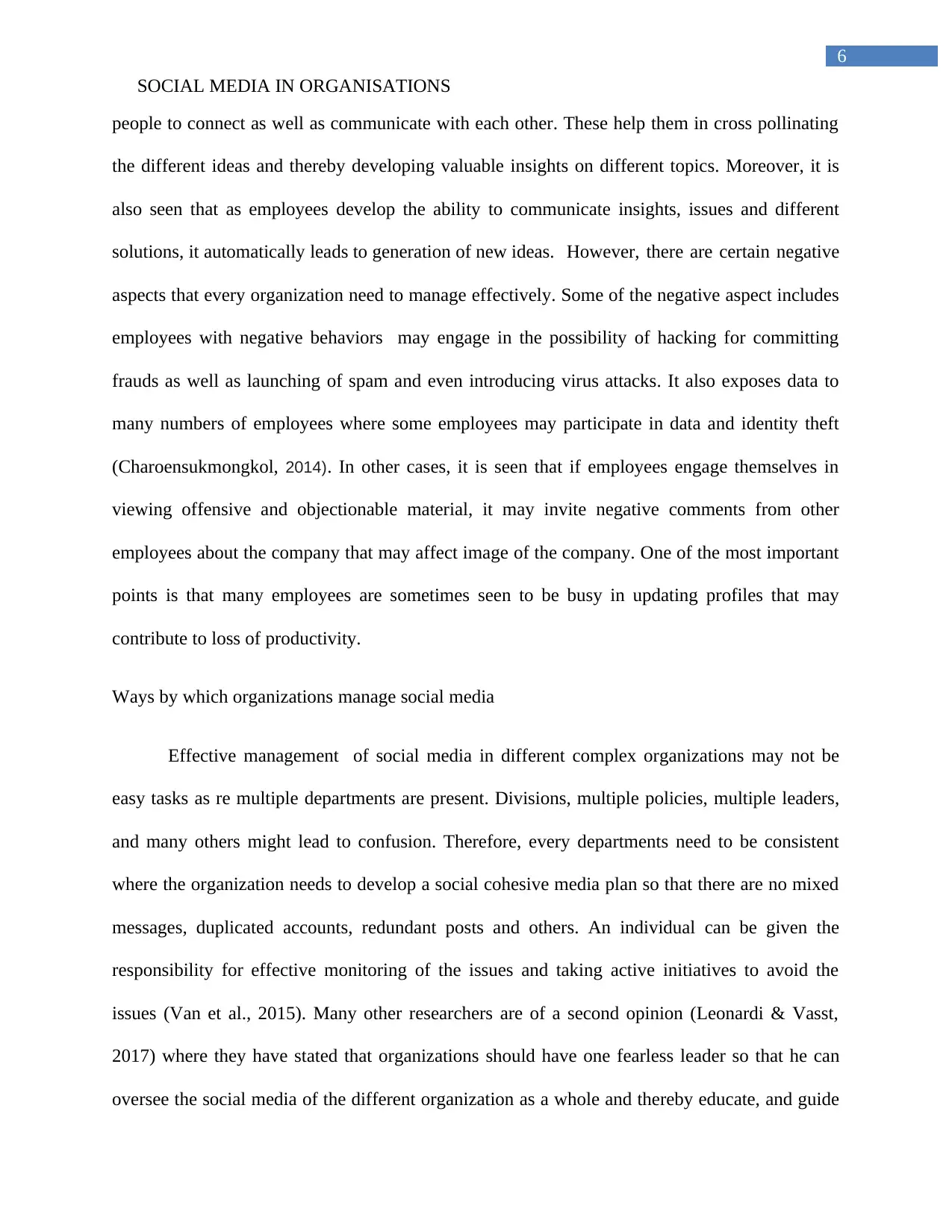
6
SOCIAL MEDIA IN ORGANISATIONS
people to connect as well as communicate with each other. These help them in cross pollinating
the different ideas and thereby developing valuable insights on different topics. Moreover, it is
also seen that as employees develop the ability to communicate insights, issues and different
solutions, it automatically leads to generation of new ideas. However, there are certain negative
aspects that every organization need to manage effectively. Some of the negative aspect includes
employees with negative behaviors may engage in the possibility of hacking for committing
frauds as well as launching of spam and even introducing virus attacks. It also exposes data to
many numbers of employees where some employees may participate in data and identity theft
(Charoensukmongkol, 2014). In other cases, it is seen that if employees engage themselves in
viewing offensive and objectionable material, it may invite negative comments from other
employees about the company that may affect image of the company. One of the most important
points is that many employees are sometimes seen to be busy in updating profiles that may
contribute to loss of productivity.
Ways by which organizations manage social media
Effective management of social media in different complex organizations may not be
easy tasks as re multiple departments are present. Divisions, multiple policies, multiple leaders,
and many others might lead to confusion. Therefore, every departments need to be consistent
where the organization needs to develop a social cohesive media plan so that there are no mixed
messages, duplicated accounts, redundant posts and others. An individual can be given the
responsibility for effective monitoring of the issues and taking active initiatives to avoid the
issues (Van et al., 2015). Many other researchers are of a second opinion (Leonardi & Vasst,
2017) where they have stated that organizations should have one fearless leader so that he can
oversee the social media of the different organization as a whole and thereby educate, and guide
SOCIAL MEDIA IN ORGANISATIONS
people to connect as well as communicate with each other. These help them in cross pollinating
the different ideas and thereby developing valuable insights on different topics. Moreover, it is
also seen that as employees develop the ability to communicate insights, issues and different
solutions, it automatically leads to generation of new ideas. However, there are certain negative
aspects that every organization need to manage effectively. Some of the negative aspect includes
employees with negative behaviors may engage in the possibility of hacking for committing
frauds as well as launching of spam and even introducing virus attacks. It also exposes data to
many numbers of employees where some employees may participate in data and identity theft
(Charoensukmongkol, 2014). In other cases, it is seen that if employees engage themselves in
viewing offensive and objectionable material, it may invite negative comments from other
employees about the company that may affect image of the company. One of the most important
points is that many employees are sometimes seen to be busy in updating profiles that may
contribute to loss of productivity.
Ways by which organizations manage social media
Effective management of social media in different complex organizations may not be
easy tasks as re multiple departments are present. Divisions, multiple policies, multiple leaders,
and many others might lead to confusion. Therefore, every departments need to be consistent
where the organization needs to develop a social cohesive media plan so that there are no mixed
messages, duplicated accounts, redundant posts and others. An individual can be given the
responsibility for effective monitoring of the issues and taking active initiatives to avoid the
issues (Van et al., 2015). Many other researchers are of a second opinion (Leonardi & Vasst,
2017) where they have stated that organizations should have one fearless leader so that he can
oversee the social media of the different organization as a whole and thereby educate, and guide
Paraphrase This Document
Need a fresh take? Get an instant paraphrase of this document with our AI Paraphraser
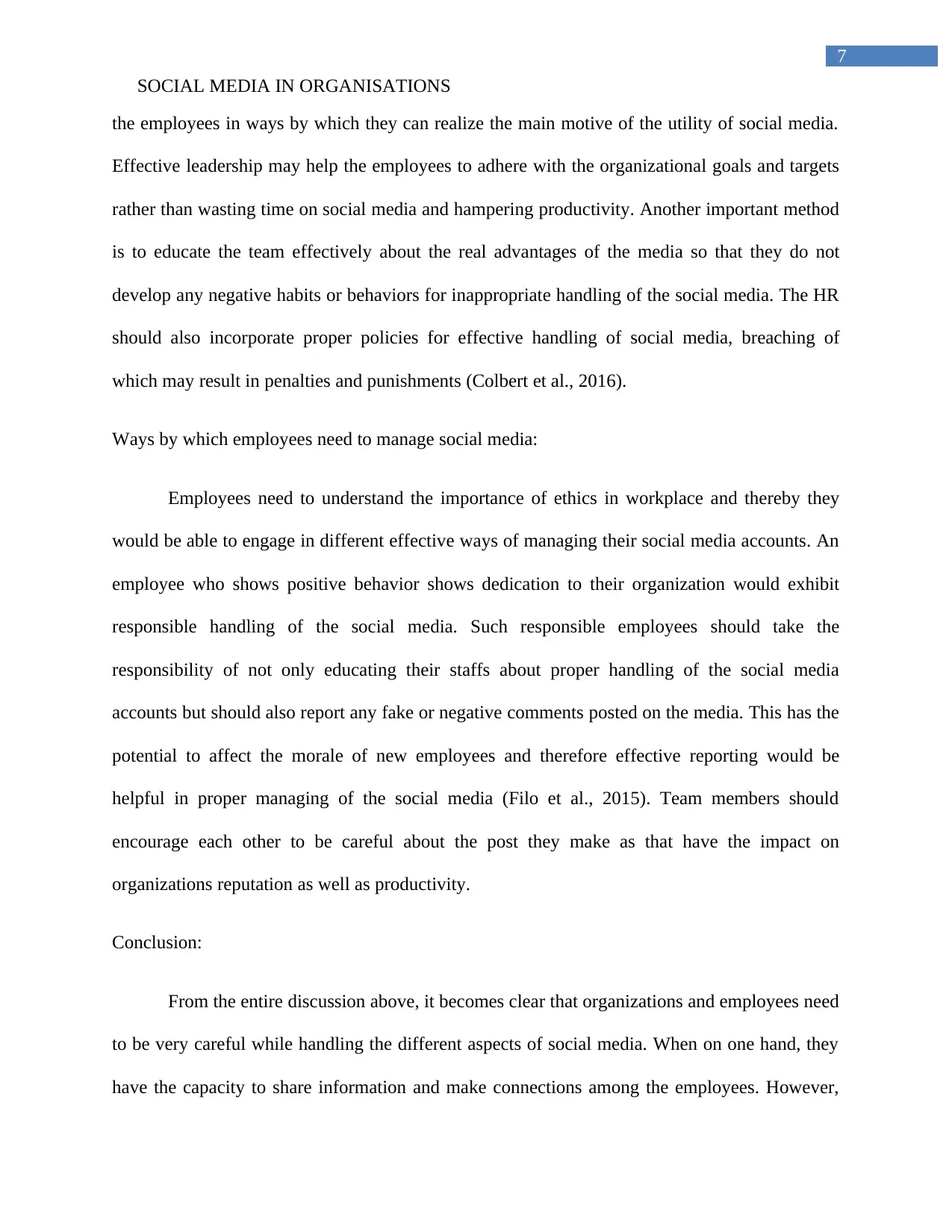
7
SOCIAL MEDIA IN ORGANISATIONS
the employees in ways by which they can realize the main motive of the utility of social media.
Effective leadership may help the employees to adhere with the organizational goals and targets
rather than wasting time on social media and hampering productivity. Another important method
is to educate the team effectively about the real advantages of the media so that they do not
develop any negative habits or behaviors for inappropriate handling of the social media. The HR
should also incorporate proper policies for effective handling of social media, breaching of
which may result in penalties and punishments (Colbert et al., 2016).
Ways by which employees need to manage social media:
Employees need to understand the importance of ethics in workplace and thereby they
would be able to engage in different effective ways of managing their social media accounts. An
employee who shows positive behavior shows dedication to their organization would exhibit
responsible handling of the social media. Such responsible employees should take the
responsibility of not only educating their staffs about proper handling of the social media
accounts but should also report any fake or negative comments posted on the media. This has the
potential to affect the morale of new employees and therefore effective reporting would be
helpful in proper managing of the social media (Filo et al., 2015). Team members should
encourage each other to be careful about the post they make as that have the impact on
organizations reputation as well as productivity.
Conclusion:
From the entire discussion above, it becomes clear that organizations and employees need
to be very careful while handling the different aspects of social media. When on one hand, they
have the capacity to share information and make connections among the employees. However,
SOCIAL MEDIA IN ORGANISATIONS
the employees in ways by which they can realize the main motive of the utility of social media.
Effective leadership may help the employees to adhere with the organizational goals and targets
rather than wasting time on social media and hampering productivity. Another important method
is to educate the team effectively about the real advantages of the media so that they do not
develop any negative habits or behaviors for inappropriate handling of the social media. The HR
should also incorporate proper policies for effective handling of social media, breaching of
which may result in penalties and punishments (Colbert et al., 2016).
Ways by which employees need to manage social media:
Employees need to understand the importance of ethics in workplace and thereby they
would be able to engage in different effective ways of managing their social media accounts. An
employee who shows positive behavior shows dedication to their organization would exhibit
responsible handling of the social media. Such responsible employees should take the
responsibility of not only educating their staffs about proper handling of the social media
accounts but should also report any fake or negative comments posted on the media. This has the
potential to affect the morale of new employees and therefore effective reporting would be
helpful in proper managing of the social media (Filo et al., 2015). Team members should
encourage each other to be careful about the post they make as that have the impact on
organizations reputation as well as productivity.
Conclusion:
From the entire discussion above, it becomes clear that organizations and employees need
to be very careful while handling the different aspects of social media. When on one hand, they
have the capacity to share information and make connections among the employees. However,
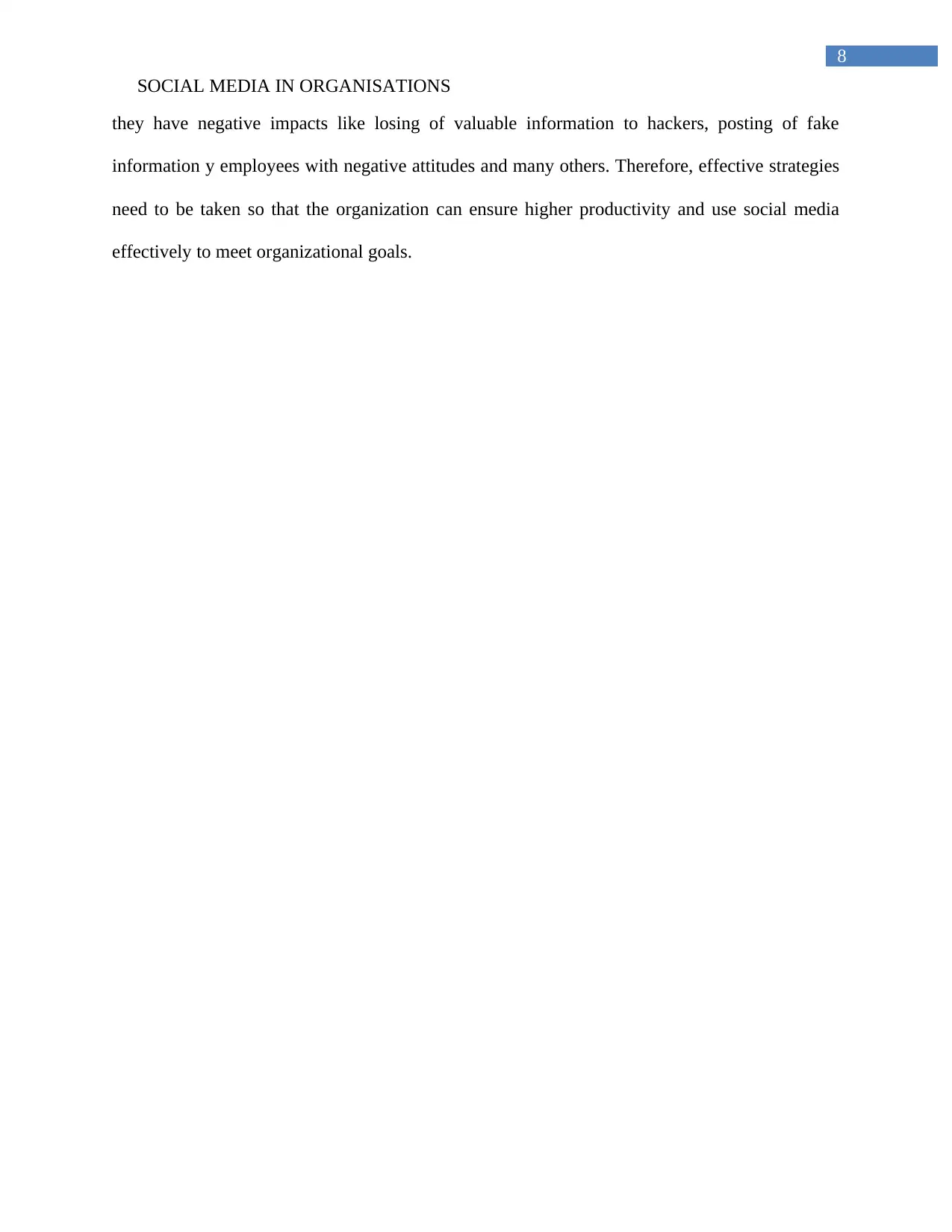
8
SOCIAL MEDIA IN ORGANISATIONS
they have negative impacts like losing of valuable information to hackers, posting of fake
information y employees with negative attitudes and many others. Therefore, effective strategies
need to be taken so that the organization can ensure higher productivity and use social media
effectively to meet organizational goals.
SOCIAL MEDIA IN ORGANISATIONS
they have negative impacts like losing of valuable information to hackers, posting of fake
information y employees with negative attitudes and many others. Therefore, effective strategies
need to be taken so that the organization can ensure higher productivity and use social media
effectively to meet organizational goals.
⊘ This is a preview!⊘
Do you want full access?
Subscribe today to unlock all pages.

Trusted by 1+ million students worldwide
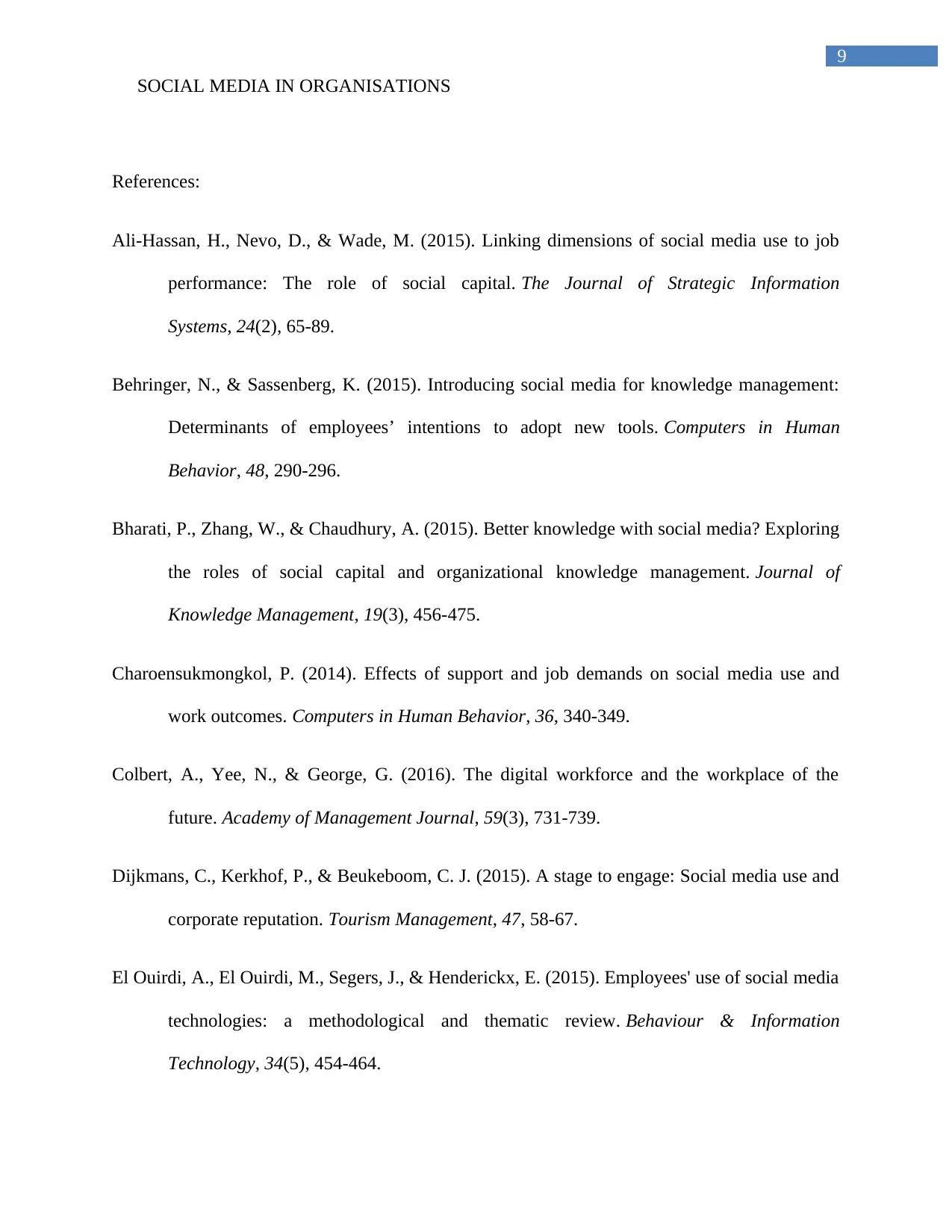
9
SOCIAL MEDIA IN ORGANISATIONS
References:
Ali-Hassan, H., Nevo, D., & Wade, M. (2015). Linking dimensions of social media use to job
performance: The role of social capital. The Journal of Strategic Information
Systems, 24(2), 65-89.
Behringer, N., & Sassenberg, K. (2015). Introducing social media for knowledge management:
Determinants of employees’ intentions to adopt new tools. Computers in Human
Behavior, 48, 290-296.
Bharati, P., Zhang, W., & Chaudhury, A. (2015). Better knowledge with social media? Exploring
the roles of social capital and organizational knowledge management. Journal of
Knowledge Management, 19(3), 456-475.
Charoensukmongkol, P. (2014). Effects of support and job demands on social media use and
work outcomes. Computers in Human Behavior, 36, 340-349.
Colbert, A., Yee, N., & George, G. (2016). The digital workforce and the workplace of the
future. Academy of Management Journal, 59(3), 731-739.
Dijkmans, C., Kerkhof, P., & Beukeboom, C. J. (2015). A stage to engage: Social media use and
corporate reputation. Tourism Management, 47, 58-67.
El Ouirdi, A., El Ouirdi, M., Segers, J., & Henderickx, E. (2015). Employees' use of social media
technologies: a methodological and thematic review. Behaviour & Information
Technology, 34(5), 454-464.
SOCIAL MEDIA IN ORGANISATIONS
References:
Ali-Hassan, H., Nevo, D., & Wade, M. (2015). Linking dimensions of social media use to job
performance: The role of social capital. The Journal of Strategic Information
Systems, 24(2), 65-89.
Behringer, N., & Sassenberg, K. (2015). Introducing social media for knowledge management:
Determinants of employees’ intentions to adopt new tools. Computers in Human
Behavior, 48, 290-296.
Bharati, P., Zhang, W., & Chaudhury, A. (2015). Better knowledge with social media? Exploring
the roles of social capital and organizational knowledge management. Journal of
Knowledge Management, 19(3), 456-475.
Charoensukmongkol, P. (2014). Effects of support and job demands on social media use and
work outcomes. Computers in Human Behavior, 36, 340-349.
Colbert, A., Yee, N., & George, G. (2016). The digital workforce and the workplace of the
future. Academy of Management Journal, 59(3), 731-739.
Dijkmans, C., Kerkhof, P., & Beukeboom, C. J. (2015). A stage to engage: Social media use and
corporate reputation. Tourism Management, 47, 58-67.
El Ouirdi, A., El Ouirdi, M., Segers, J., & Henderickx, E. (2015). Employees' use of social media
technologies: a methodological and thematic review. Behaviour & Information
Technology, 34(5), 454-464.
Paraphrase This Document
Need a fresh take? Get an instant paraphrase of this document with our AI Paraphraser
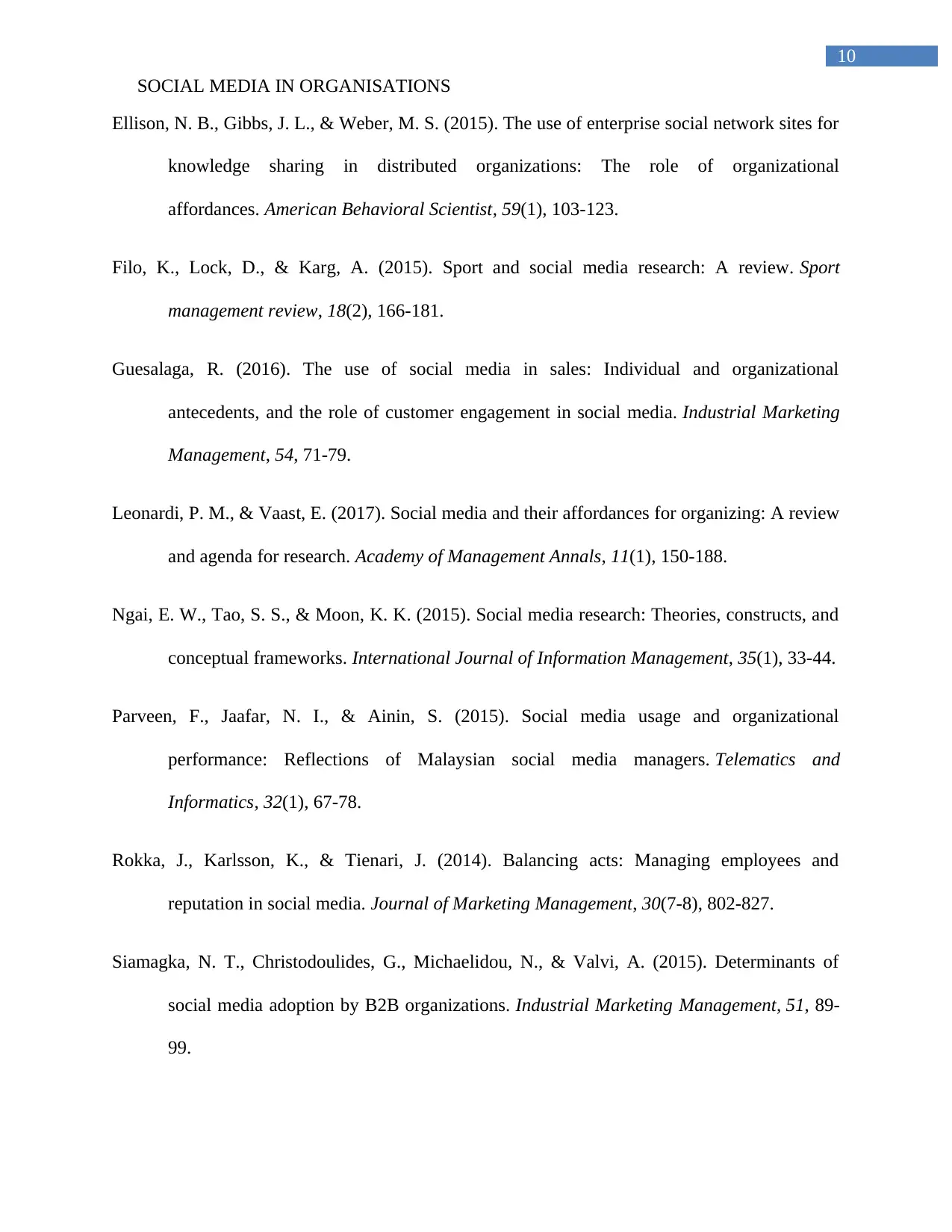
10
SOCIAL MEDIA IN ORGANISATIONS
Ellison, N. B., Gibbs, J. L., & Weber, M. S. (2015). The use of enterprise social network sites for
knowledge sharing in distributed organizations: The role of organizational
affordances. American Behavioral Scientist, 59(1), 103-123.
Filo, K., Lock, D., & Karg, A. (2015). Sport and social media research: A review. Sport
management review, 18(2), 166-181.
Guesalaga, R. (2016). The use of social media in sales: Individual and organizational
antecedents, and the role of customer engagement in social media. Industrial Marketing
Management, 54, 71-79.
Leonardi, P. M., & Vaast, E. (2017). Social media and their affordances for organizing: A review
and agenda for research. Academy of Management Annals, 11(1), 150-188.
Ngai, E. W., Tao, S. S., & Moon, K. K. (2015). Social media research: Theories, constructs, and
conceptual frameworks. International Journal of Information Management, 35(1), 33-44.
Parveen, F., Jaafar, N. I., & Ainin, S. (2015). Social media usage and organizational
performance: Reflections of Malaysian social media managers. Telematics and
Informatics, 32(1), 67-78.
Rokka, J., Karlsson, K., & Tienari, J. (2014). Balancing acts: Managing employees and
reputation in social media. Journal of Marketing Management, 30(7-8), 802-827.
Siamagka, N. T., Christodoulides, G., Michaelidou, N., & Valvi, A. (2015). Determinants of
social media adoption by B2B organizations. Industrial Marketing Management, 51, 89-
99.
SOCIAL MEDIA IN ORGANISATIONS
Ellison, N. B., Gibbs, J. L., & Weber, M. S. (2015). The use of enterprise social network sites for
knowledge sharing in distributed organizations: The role of organizational
affordances. American Behavioral Scientist, 59(1), 103-123.
Filo, K., Lock, D., & Karg, A. (2015). Sport and social media research: A review. Sport
management review, 18(2), 166-181.
Guesalaga, R. (2016). The use of social media in sales: Individual and organizational
antecedents, and the role of customer engagement in social media. Industrial Marketing
Management, 54, 71-79.
Leonardi, P. M., & Vaast, E. (2017). Social media and their affordances for organizing: A review
and agenda for research. Academy of Management Annals, 11(1), 150-188.
Ngai, E. W., Tao, S. S., & Moon, K. K. (2015). Social media research: Theories, constructs, and
conceptual frameworks. International Journal of Information Management, 35(1), 33-44.
Parveen, F., Jaafar, N. I., & Ainin, S. (2015). Social media usage and organizational
performance: Reflections of Malaysian social media managers. Telematics and
Informatics, 32(1), 67-78.
Rokka, J., Karlsson, K., & Tienari, J. (2014). Balancing acts: Managing employees and
reputation in social media. Journal of Marketing Management, 30(7-8), 802-827.
Siamagka, N. T., Christodoulides, G., Michaelidou, N., & Valvi, A. (2015). Determinants of
social media adoption by B2B organizations. Industrial Marketing Management, 51, 89-
99.
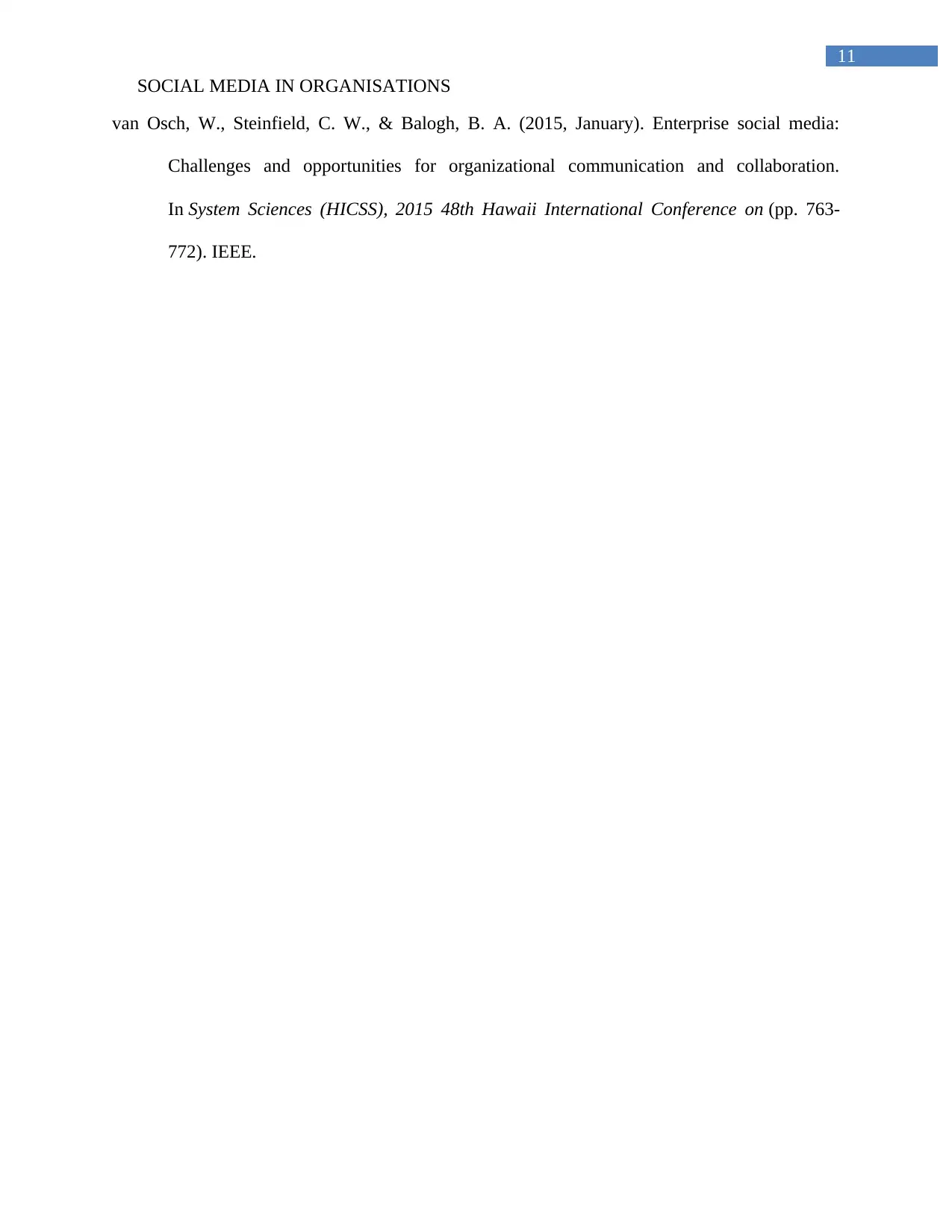
11
SOCIAL MEDIA IN ORGANISATIONS
van Osch, W., Steinfield, C. W., & Balogh, B. A. (2015, January). Enterprise social media:
Challenges and opportunities for organizational communication and collaboration.
In System Sciences (HICSS), 2015 48th Hawaii International Conference on (pp. 763-
772). IEEE.
SOCIAL MEDIA IN ORGANISATIONS
van Osch, W., Steinfield, C. W., & Balogh, B. A. (2015, January). Enterprise social media:
Challenges and opportunities for organizational communication and collaboration.
In System Sciences (HICSS), 2015 48th Hawaii International Conference on (pp. 763-
772). IEEE.
⊘ This is a preview!⊘
Do you want full access?
Subscribe today to unlock all pages.

Trusted by 1+ million students worldwide
1 out of 12
Related Documents
Your All-in-One AI-Powered Toolkit for Academic Success.
+13062052269
info@desklib.com
Available 24*7 on WhatsApp / Email
![[object Object]](/_next/static/media/star-bottom.7253800d.svg)
Unlock your academic potential
Copyright © 2020–2025 A2Z Services. All Rights Reserved. Developed and managed by ZUCOL.




